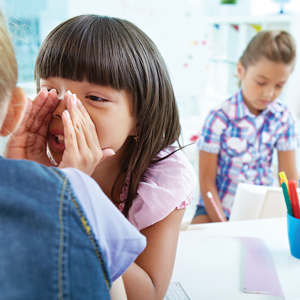When I was in eighth grade, I missed two weeks of school to go to Europe with my parents, which was great. When I returned, however, the leader in my group of gal pals had decided she didn’t want me to hang around with them anymore. Not so great. The small but potent gang of teens spent a good deal of energy harassing me with insults, leaving nasty notes on my locker, and telling other kids at school how much they hated me.In short, I was bullied. And, being a couple decades ago, no bullying laws were in effect, even in my home state of California.So, I cried. A lot. My mom eventually enlisted the help of the school counselor, and life gradually got better.
Actually, I got off easy – and in retrospect, so did the girls who bullied me mercilessly. Bullying, defined today as “repeated negative behaviors intended to frighten or cause harm,” can be very, very serious. It can cause physical harm and deep psychological damage, even to the point of a Virginia teen taking his own life in 2010 because he was harassed about his sexual orientation. But there are legal protections in place. Together with implementation by school personnel, involved parents, and active communities, these laws can help reduce the amount of bullying experienced by our children and teens.
Here are the basics:
1. Virginia has made criminal the following acts which often accompany bullying: threats, harassment, extortion, assault and battery, robbery, and hazing. People who commit these acts, including kids and youth, could be found criminally liable.
2. Local school boards are required to establish character education programs that address bullying, including cyberbullying and the generally noncriminal behaviors of intimidation, taunting, and name-calling. These policies vary between districts, but most include some elements of student education, staff training, interventions with students who bully, and parent communications.If you are not aware of the policy at your child’s school, ask about it and give your feedback to school administrators and school board members.
3. Harassment based on race, color, national origin, sex, and disability can trigger civil rights violations, if it is severe enough to block the victim’s access to an educational benefit. Schools are responsible for responding to such incidents about which the school knows or reasonably should have known, including taking prompt steps to end the harassment, to eliminate a hostile environment, and to prevent the harassment from recurring.Here’s an exmaple: If a female youth is repeatedly harassed for wearing stereotypically male clothing, and this harassment has been reported to the school, the school has an affirmative duty to act. Tell your child to report to you – or a school official- any such bullying.
The bottom line is that both federal and state laws take bullying very seriously. If you feel your child is being bullied, contact school officials and assert your child’s rights. I am an advocate by profession, but the most significant advocating I do is as a parent. Knowing that my child deserves protection from bullying under the law provides me with the resources I need to help protect her, and other children.




